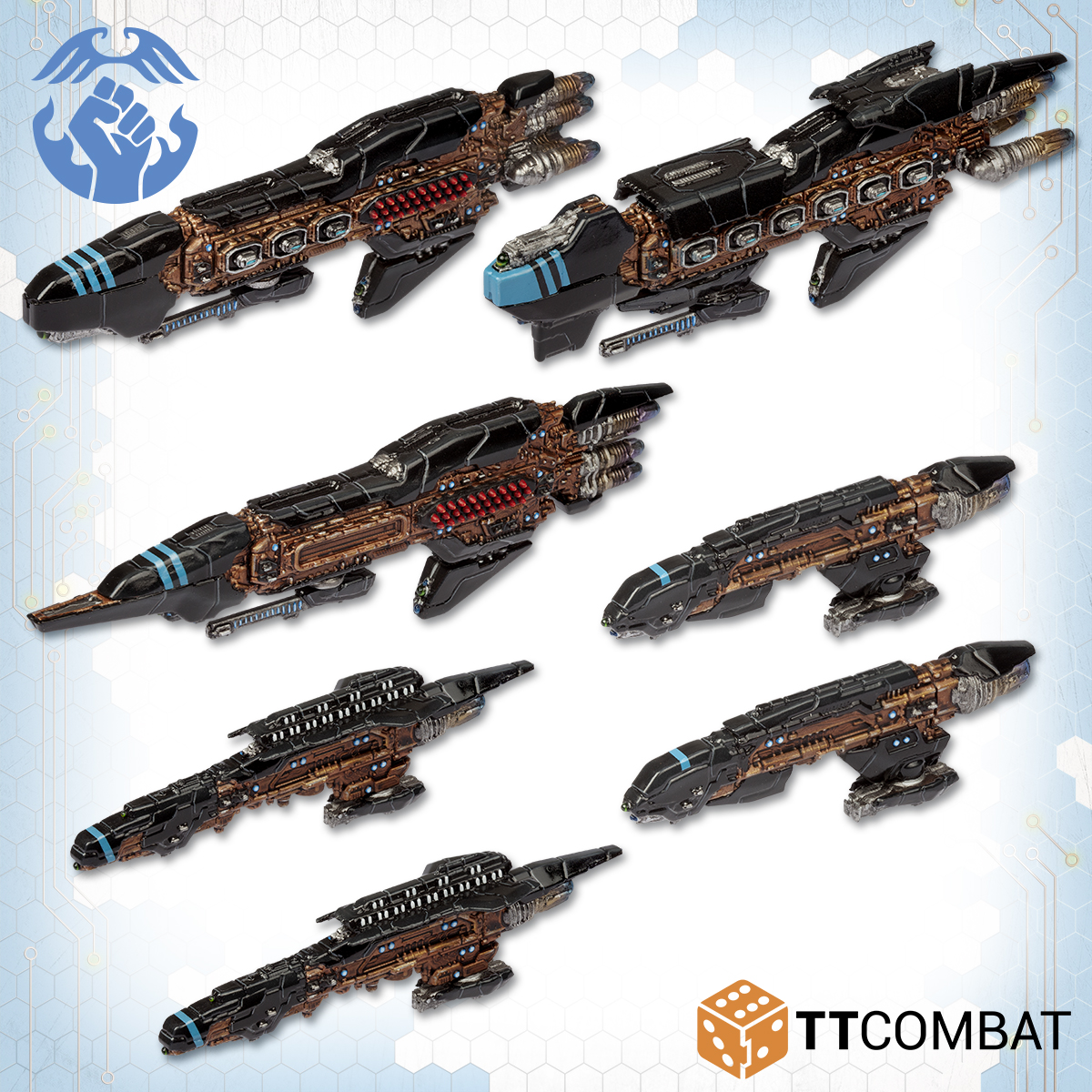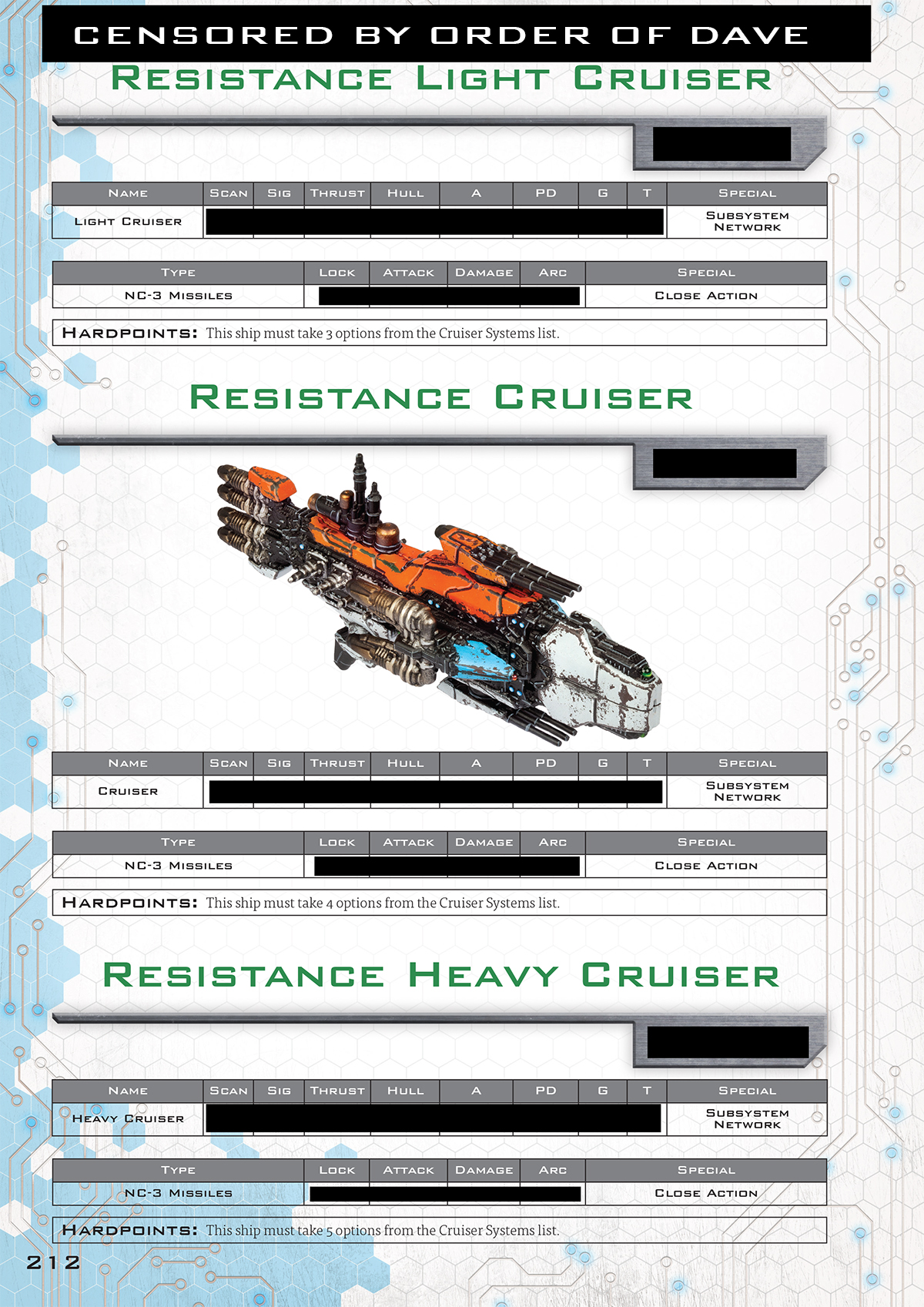How do you make Resistance ships? Let’s find out!
We’ve had a lot of people asking exactly how this “build your own ship” mechanic works for Resistance Frigates and Cruisers, so let’s delve into it, shall we?
Modular Ships
For those that haven’t been paying attention, the Resistance Cruisers and Frigates introduce a whole new way of building your fleets. Rather than a dozen set classes of ship like you may see in other factions, the Frigates and Cruisers can be built in a whole load of different ways!
This is to represent the way that ships used to be built back in the Earth days, before the Scourge invasion. With hundreds (if not thousands) of companies competing in a free market to produce space ship designs, it got very tricky to get replacement parts for ships. So a standard fitting design was agreed on, meaning each company could work on one particular aspect if they wanted to (engines, prows, armour, weapons etc), and be fairly sure that their products could be used on any ship. This meant that no two ships would be entirely alike. Due to the bloated economy of pre-war Earth, simply replacing entire parts of ships was a viable option, which also meant that a ship that had been in service a while often had any number of redundant or backup systems in place!
Resistance Frigates
We’ll start off with the small class of ship. Frigates for Resistance come in three types: Frigate, Heavy Frigates, and Strike Carriers.
You’ll see above the three stat sheets, and while I’ve been asked to redact some of the information (we want you to have some surprises when you pick up the book!), you can see what options they have.
Hardpoints are what we use to determine how many weapons or options a ship can take, and they’re reflected on the Frigate models by little nubbins to attach bits to. A regular Frigate can (and indeed must) take one option from the list.
A Heavy Frigate automatically comes with Ablative Armour, and an option for an extra hardpoint. Note that you don’t have to take 2 options on a Heavy Frigate, meaning you can just pay a few extra points for something that’s more survivable.
Finally, the Strike Carrier comes with Dropships to launch, and can go Atmospheric. Pretty standard for a strike carrier! Interestingly the Strike Carrier can take up to one option from the Systems list, which means you can have light Strike Carriers with no weapons, or kit them out to deal with attackers.
Frigate Systems
The Frigate Systems list is quite short, but with three different types of ship to start with and three guns and a Sensor Dome, you have quite a lot of options!
Each option from the Systems list costs a number of points (carefully redacted here!) which are just added to the base cost of the ship.
Note that there’s no limit to multiple options, so you can double up on the weapons on a Heavy Frigate if you’d like!
You’ll see we left the special rules in the picture. Some you’ll recognise, like Scald, and others are a little new. Some people will have seen Squadron before in the Adepticon FAQ. That FAQ isn’t official, but both Dave and Don provided feedback on it, meaning some of the things in there are coming to BfE.
At the bottom you can see two Kalium Frigates – one regular and one Heavy. They’re both armed with Hybrid Guns, and the Heavy Cruiser also has a Sensor Dome.
Resistance Cruisers
Now we’re onto the big guns (literally). The Cruisers! This kit is a real work of art, and we wanted the rules to reflect its great many options while still being easy to understand.
There’s very little on show to distinguish the Cruisers, although I can safely say that they have differences in their statlines. Heavy Cruisers are slower and have higher Hull, while Light Cruisers have a tiny Signature.
The big difference is on how many hard points they have. 3 for a Light Cruiser, 4 for a Cruiser, and 5 for a Heavy Cruiser.
Other than that there are two things to note. The first is that each Cruiser comes with a Close Action weapon. It’s free and it’s… well it’s okay, not great. The second thing is that they all have the Subsystem Network special rule. The Heavy Frigate also has this rule. I won’t go into too many details, but essentially it means that you can “twin-link” your weapon options very easily. This is a rule that’s been in here in some form since the start of the Resistance Fleet, and means you have complete modularity without having to worry about each individual weapon being a bit rubbish on their own. It’s basically the modular equivalent of the Moscow’s twin Mass Driver turrets.
Cruiser Systems
Okay, here’s the meat and potatoes of building your fleet! This page is pretty bananas.
A few rules first:
- Only 2 Broadsides. That’s because there’s only space for 2!
- Only 1 of each Structure can be taken.
Other than that, you can go nuts!
Each of these options takes up a single hard point, but you get a lot of versatility in there. For example a Broadside Bank option gives you both left and right firing Linked weapons. There’s also a Broadside option to upgrade your missiles, giving your Cruiser some really great Close Action weaponry to add to their starting one!
Artillery Cannons are those big, multi-barrelled guns we’ve seen that look like they’re inspired directly from aircraft carriers. They have the Low Power special rule. Although they’re not very powerful, they also don’t draw much power from the main systems, allowing them to fire more often.
Vent Cannons are something seen throughout the Resistance Fleet, and they’re pretty dangerous! However, venting the power core directly into your guns comes with its problems, as evidenced by the Unstable special rule. It has the chance to be dangerous to your own ship!
Finally, the Structures options come with some interesting things. The Drive Refit adds to your Thrust, Scanner Array your Scan, and Ablative Armour – well that one’s kind of obvious. These offer huge chances to change how your fleet plays, if you want to trade up the weapons slots that is!
There Are So Many Options!
Yep, pretty much.
But how do you tell them apart? We we’ll hopefully have Dave in soon to give some designer’s notes on the fleet, but the low down of it is that we made things very obvious.
The weapons on Resistance ships are deliberately quite large. It fits with their unsubtle design, and means that your opponents will be able to see quite easily what ships have what weapon.
We also use colour schemes to separate the weapons. You’ll see that all the Vent Cannons have a bright green hue, the Missiles are in red, and Hybrid Guns have blue on their barrels. Of course you don’t have to paint yours the same colour, but we do recommend using a strong colour scheme to help your opponents to see what is what.
If all this tickles your fancy, why not pick up a Resistance Starter Fleet? They’re available to pre-order now in the TTCombat webstore.








